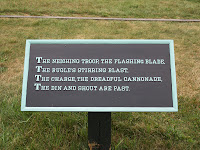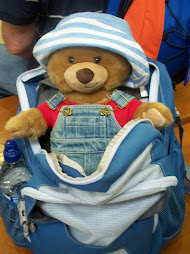
On our only morning in Washington DC. Ms. Edwards and Ms. Wood decided to go on a morning tour of Washington DC. The tour guide supplied a lot of information about the city and the sites of DC.
One place that the tour stopped at was the Capitol building . The bus driver dropped us off and we stood in line and picked up ticket to see the inside of the building.

While waiting to go into the capitol Ms. Wood walked around and took some interesting pictures. At the U.S. Botanic Garden there were several globes around the outside. They were a fundraiser to raise money for environmental programs.

Here is another example of one of the globes that was seen at the garden.

The United States Capitol is the home of the
legislative branch. Both the Senate and the House have chambers. The building is located on Capitol Hill and is at the end of the National Mall. Construction began on September 18, 1793.
The original design for the building was created by William Thornton and was changed by Stephen
Hallet, Benjamin Latrobe, and Charles Bulfinch.
At the center of the Capitol is a central dome and rotunda. There are two wings to the left and right. One side is the home of the Senate and the other the Home of the House of Representatives.

Inside the dome are eights paintings of different scenes from American history. The scenes were painted by different artist.
The Baptism of Pocahontas - John
Gadsby Chapman
The Embarkation of the Pilgrims - Robert W. Weir
The Discovery of the Mississippi - William H. Powell
The Landing of Columbus - John
VanderlynThe Declaration of Independence - John Trumbull
The Surrender of General Burgoyne - John Trumbull
The Surrender of Lord Cornwallis - John Trumbull (which can be seen above)
General George Washington Resigning His Commission - John Trumbull.

On the dome is an amazing painting that was painted by Constantino
Brumidi. He painted
The Apotheosis of Washington which he completed in 11 months. Washington is painted with 13 maidens surrounding him.
Surrounding the inner ring are many Greek and Roman gods and goddesses.
Below the dome is a chronological, pictorial history of the United States. It starts with the landing of Christopher Columbus and goes through to the Wright Brother's flight in Kitty Hawk.

From the outside of the of the Capitol one has many views is of the Washington Monument and the National Mall.

Inside the Capitol is this star that marks the center of the Capitol city. There are many markers inside of the Capitol that
deplicts many different historical events that occurred. One can see the the spot where many historical men sat in the House and Senate. There is the spot that John Q. Adams desk was located and where he died. There is also the spot where a cat walked across the floor and left its pay prints in the cement. In one of the stairwells is bullet holes from when the British stormed into the Capitol during the War of 1812.
There are many statutes throughout the Capitol as well. Each state was allowed to make two statutes to represent people of their states. Throughout the capitol can be found the different statues. The statues that represent Maine are Hannibal Hamlin and William King
http://en.wikipedia.org/wiki/United_States_Capitol



 On our way out of Washington DC we stopped by the Iwo Jima Memorial. The memorial was created to honor our marines who fought for our country. Around the monument is the names of all the conflicts and battles that the marines have fought in.
On our way out of Washington DC we stopped by the Iwo Jima Memorial. The memorial was created to honor our marines who fought for our country. Around the monument is the names of all the conflicts and battles that the marines have fought in.  Ms. Edwards and Ms. Wood went to the Holocaust Museum and walked the three floors of exhibits that were dedicated to the time period in history when the Jewish people of Europe were persecuted against by the Nazi Party and Hitler. They were not able to take pictures inside the museum and they wouldn't let me out of the backpack. Below are two pictures that Ms. Edwards took outside of the museum.
Ms. Edwards and Ms. Wood went to the Holocaust Museum and walked the three floors of exhibits that were dedicated to the time period in history when the Jewish people of Europe were persecuted against by the Nazi Party and Hitler. They were not able to take pictures inside the museum and they wouldn't let me out of the backpack. Below are two pictures that Ms. Edwards took outside of the museum.













